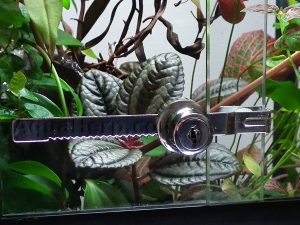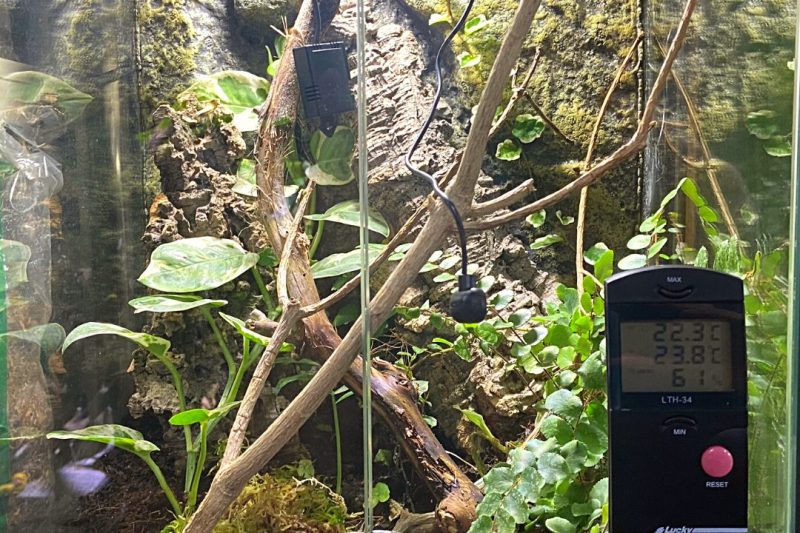
How To Fit A Lock To A Vivarium – A Brief Guide
Reptiles, amphibians and invertebrates can be challenging to keep well. They all require careful consideration when choosing and maintaining their homes, diet, lighting and heating.

If you are keeping anything that doesn’t control its own temperature internally – as birds and mammals do – then you need to control temperature. Reptiles and amphibians don’t control their internal temperature by burning fuel (food), they move around their habitat until their bodies are the correct temperature.
This usually means that for our pet reptiles we have to control that temperature for them. Before we can control temperature, we need to know what it is!
This is where your thermometer comes in. Whether you keep reptiles, amphibians or fish, a thermometer is an invaluable piece of kit.
In this article we will cover types of thermometer, why you need one, which one to choose and how to place it to get the best and most accurate results.
So what is a thermometer? The simplest definition is that a thermometer is an instrument to measure temperature. They can be made of various materials that change when exposed to different temperatures, and those changes are calibrated against a scale.
Thermometers come in all shapes and sizes, and we can help you to select the one that most meets the needs of you and your pet.
There are several common types of thermometer that are offered for use in a vivarium:
As we mentioned in the introduction, it is vitally important to know the temperature of your pet’s housing. For reptiles and amphibians, temperature control – so that they can eat, move, digest their food and function normally – is external. They have to move around their habitat to bring their bodies to the right temperature, which is where we come in! As a keeper, you need to provide a range of temperatures that suit your pet, from warm to cool, and prevent the housing from getting too hot or too cold.
Of course, ‘warm’ and ‘cool’ are relative terms. Some reptiles and almost all amphibians thrive at temperatures we ourselves would find uncomfortably chilly. Others like it very hot indeed, but most are somewhere in the middle.
So before you add any heating or cooling equipment, you need to know what the temperature in the vivarium is. Of course, once you’ve added it you need to check that you are getting the correct temperature you are aiming for, so an accurate thermometer is vital.
Once you have your thermometer, you need to decide where you should place it. We need our pets to be able to adjust their temperature, so we need to provide a temperature gradient from warm to cool.
Some species need an area to bask, a hotspot, then a gradient from there down to the coolest area, whereas others just need a steady change from warm to cool.
Before you decide where to put your thermometer, think about what sort of temperatures you are trying to achieve for your pet. Ask yourself:
Once you have the answers to those questions, you can decide where your thermometer needs to be.
Arboreal animals: You are aiming to achieve a temperature gradient not only horizontally, but vertically too. In this case you need to be reading the temperature:
Terrestrial animals: The temperature from side to side at the level the animal will be spending most time, which in the majority of cases will be on the floor. So you need to measure the temperature:
Animals that bask: For those species that need a particular hotspot as well as a smooth temperature gradient, you will need to read temperature:
Now that you know where you need to read temperature, it’s time to choose your thermometer. We always recommend using a digital thermometer for accuracy, and an infrared thermometer for double checking surface temperatures. This is especially important for reptiles that need a high basking temperature, such as bearded dragons, uromastyx, or monitor lizards.
If you choose a digital thermometer with only one probe then you may well need more than one in order to watch your temperatures closely. You can, of course, take several days and move the probe around to read temperature in different areas. There are digital thermometers with several probes, and these are very useful for overall monitoring.
Also, consider whether you need to also measure humidity. For many of our more commonly kept pets – such as bearded dragons, or corn snakes – humidity isn’t such an issue. Background humidity in the UK is absolutely fine for them, and they are robust enough to tolerate quite large fluctuations in the background levels. Some animals, however, such as chameleons and other more delicate species, should have their humidities monitored constantly. In cases like those, then a combined thermometer/hygrometer is worth considering.
Once you have decided on the type, then it’s time to look at specifics.
These are the products that we recommend, as we have used them ourselves and find that they are the best way to measure temperature in your vivarium.
This electronic thermometer has two external sensors which allows measuring the temperature in two different spots. The sensors can also be used for measurements in water. The device has a large display for easy readouts and a clock function. This is the one that we use ourselves, as it is robust and accurate and allows temperature to be measured in two places simultaneously. Long probe leads also make it very easy to position the main box in an area that is most convenient for viewing.
Modern Digital Thermometer with maximum and minimum temperature reading capability through external sensor. Features attaching clip and suction cup and comes complete with batteries. Measurement range -50ºC to 70ºC. Stylish and accurate, but only has one probe. Very useful for placing in the centre of your vivarium in order to keep an eye on the maximum and minimum ambient temperature.
ZooMed’s Digital Terrarium Thermometer has a remote sensor for accurate readings. Temperature can be displayed in Celsius or Fahrenheit. It has a single waterproof temperature probe, and the digital display should be mounted in a dry location outside the enclosure. Only one probe and no max/min function, but a cheap and cheerful way to watch your temperatures.
Compared to the normal Thermo-Hygrometer Deluxe the PRO model offers a combo sensor for humidity and temperature plus a second temperature sensor allowing to measure the temperature in two places. The device can be placed outside the vivarium while all measurements are made over the external sensors. A Min/Max function saves minimum and maximum values for all three sensors. A really excellent choice if constant, accurate monitoring of temperature and humidity is needed.
Modern digital thermometer and hygrometer to measure the temperature and humidity in your terrarium. Features attaching clip and suction cup and comes complete with batteries. Temp range -5ºC to 50ºC. Humidity 20%Rh – 90%. No max/min function and only one probe, but if you need a quick read of the ambient temperature and humidity in your vivarium this is a very economical way to do it.
We hope that you have found this guide useful, and that it has made your selection of the right thermometer a little easier. Remember that we are always available to help you choose the right thermometer for your pet, just drop us a line at evolutionreptiles.co.uk or give us a call on 01865 372200. Our specialist team is happy to help with this or any other queries you might have about your reptile pet.
Alternatively, pop in and visit us at our Kidlington store, where you can browse our large range of vivariums and equipment and see what animals we have currently available. We hope to see you soon!

Reptiles, amphibians and invertebrates can be challenging to keep well. They all require careful consideration when choosing and maintaining their homes, diet, lighting and heating.
Copyright 2021 Evolution Reptiles
All rights reserved.